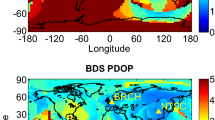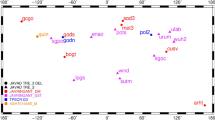Abstract
The third-generation BeiDou Navigation Satellite System (BDS-3) has provided worldwide positioning, navigation and timing since July 2020. BDS-3 is compatible with the previous B1I and B3I signals of BDS-2 and transmits the new signals of B1C, B2a and B2b. In this study, BDS-2/BDS-3 combined precise point positioning (PPP) models with B1I, B2I, B3I, B1C and B2a five-frequency observations are established, including dual-frequency (DF), triple-frequency (TF) and quad-frequency (QF) ionospheric-free (IF) combination PPP models. The proposed BDS-2/BDS-3 combined PPP models time transfer performance using four links (1331.6 km to 9501.9 km) formed from five external high-precision hydrogen clock stations. The experimental results demonstrated that compared with traditional DF1 (B1I/B3I) IF PPP solutions, the positioning accuracies of TF and QF PPP solutions are improved by 7% and 25% on average, respectively. However, the time transfer performances of TF and QF PPP solutions are not improved compared with traditional DF1 PPP solutions. Influenced by the day boundary jumps of the BDS satellite precision clock offsets, the short-term stabilities of BDS-2/BDS-3 combined PPP solutions are worse than that of GPS PPP solutions, but the long-term stabilities of BDS-2/BDS-3 combined PPP solutions are close to or even better than GPS PPP solutions. Compared with GPS PPP solutions, the frequency stabilities of BDS-2/BDS-3 combined DF1, TF1, TF3, TF4, QF1, QF2, QF4 and QF6 PPP solutions at 120,000 s are improved by 15%, 1.1%, 8.6%, 7.0%, 9.9%, 1.0%, 11% and 15% on average, respectively. With the advances in multi-frequency signal modeling, precise time transfer may substantially motivate time and frequency technology.










Similar content being viewed by others
Data availability
The observation data from IGS MGEX networks are available at ftps://gdc.cddis.eosdis.nasa.gov/gps/data/daily/. The GBM precise orbit and clock products are available at ftps://gdc.cddis.eosdis.nasa.gov/gps/products/mgex/.
References
Böhm J, Niell A, Tregoning P, Schuh H (2006) Global Mapping Function (GMF): a new empirical mapping function based on numerical weather model data. Geophys Res Lett 33:3–6. https://doi.org/10.1029/2005GL025546
Böhm J, Heinkelmann R, Schuh H (2007) Short note: a global model of pressure and temperature for geodetic applications. J Geod 81:679–683. https://doi.org/10.1007/s00190-007-0135-3
Ding S, Ge Y, Dai P, Qin W, Yang X, Yu Y (2020) Considering receiver clock modeling in PPP time transfer with BDS-3 triple-frequency un-combined observations. In: China Satellite Navigation Conference (CSNC) 2020 proceedings: volume II, pp 410–421
Ge Y, Ding S, Qin W, Zhou F, Yang X, Wang S (2020) Performance of ionospheric-free PPP time transfer models with BDS-3 quad-frequency observations. Measurement 160:107836. https://doi.org/10.1016/j.measurement.2020.107836
Ge Y, Cao X, Shen F, Yang X, Wang S (2021) BDS-3/Galileo time and frequency transfer with quad-frequency precise point positioning. Remote Sens 13:2704. https://doi.org/10.3390/rs13142704
Jiao G, Song S, Ge Y, Su K, Liu Y (2019) Assessment of BeiDou-3 and multi-GNSS precise point positioning performance. Sensors 19:2496. https://doi.org/10.3390/s19112496
Jin S, Su K (2020) PPP models and performances from single- to quad-frequency BDS observations. Satell Navig 1:16. https://doi.org/10.1186/s43020-020-00014-y
Kouba J (2009) A guide to using International GNSS Service (IGS) products. IGS Central Bureau, Jet Propulsion Laboratory, Pasadena, CA, p 34
Li X, Li X, Liu G, Feng G, Yuan Y, Zhang K, Ren X (2019) Triple-frequency PPP ambiguity resolution with multi-constellation GNSS: BDS and Galileo. J Geod 93:1105–1122. https://doi.org/10.1007/s00190-019-01229-x
Li X, Li X, Liu G, Xie W, Guo F, Yuan Y, Zhang K, Feng G (2020) The phase and code biases of Galileo and BDS-3 BOC signals: effect on ambiguity resolution and precise positioning. J Geod 94(1):9. https://doi.org/10.1007/s00190-019-01336-9
Lv D, Zeng F, Han Y, Ouyang X. (2020). BDS PPP ambiguity resolution and its application on time and frequency transfer. In China Satellite Navigation Conference (CSNC) 2020 proceedings: volume II, pp 573–585
Lyard F, Lefevre F, Letellier T, Francis O (2006) Modelling the global ocean tides: modern insights from FES2004. Ocean Dyn 56:394–415. https://doi.org/10.1007/s10236-006-0086-x
Montenbruck O, Hugentobler U, Dach R, Steigenberger P, Hauschild A (2011) Apparent clock variations of the Block IIF-1 (SVN62) GPS satellite. GPS Solut 16:303–313. https://doi.org/10.1007/s10291-011-0232-x
Montenbruck O, Hauschild A, Steigenberger P, Hugentobler U, Teunissen P, Nakamura S (2012) Initial assessment of the COMPASS/BeiDou-2 regional navigation satellite system. GPS Solut 17:211–222. https://doi.org/10.1007/s10291-012-0272-x
Petit G, Luzum B (eds) (2010) IERS Conventions (2010), IERS Technical Note 36. Verlag des Bundesamts für Kartographie und Geodäsie. Frankfurt am Main, Berlin
Qin W, Ge Y, Wei P, Dai P, Yang X (2020a) Assessment of the BDS-3 on-board clocks and their impact on the PPP time transfer performance. Measurement 153:107356. https://doi.org/10.1016/j.measurement.2019.107356
Qin W, Ge Y, Zhang Z, Su H, Wei P, Yang X (2020b) Accounting BDS3–BDS2 inter-system biases for precise time transfer. Measurement 156:107566. https://doi.org/10.1016/j.measurement.2020.107566
Qin W, Ge Y, Zhang Z, Yang H, Su H, Yang X (2021) Enhancing BDS-3 precise time transfer with DCB modelling. Measurement 174:108641. https://doi.org/10.1016/j.measurement.2020.108641
Saastamoinen J (1973) Contributions to the theory of atmospheric refraction. Bulletin Géodésique 1946–1975(107):13–34. https://doi.org/10.1007/BF02522083
Shi J, Ouyang C, Huang Y, Peng W (2020) Assessment of BDS-3 global positioning service: ephemeris, SPP, PPP, RTK, and new signal. GPS Solut 24:81. https://doi.org/10.1007/s10291-020-00995-y
Shi C, Wu X, Zheng F, Wang X, Wang J (2021) Modeling of BDS-2/BDS-3 single-frequency PPP with B1I and B1C signals and positioning performance analysis. Measurement 178:109335. https://doi.org/10.1016/j.measurement.2021.109355
Su K, Jin S (2019) Triple-frequency carrier phase precise time and frequency transfer models for BDS-3: 86. GPS Solut. https://doi.org/10.1007/s10291-019-0879-2
Takasu T, Yasuda A (2009) Development of the low-cost RTK-GPS receiver with an open source program package RTKLIB. In: International symposium on GPS/GNSS, Seogwipo-si Jungmundong, Korea, 4–6 November
Wang K, Chen P, Zaminpardaz S, Teunissen PJG (2018a) Precise regional L5 positioning with IRNSS and QZSS: stand-alone and combined. GPS Solut 23:10. https://doi.org/10.1007/s10291-018-0800-4
Wang K, Khodabandeh A, Teunissen PJG (2018b) Five-frequency Galileo long-baseline ambiguity resolution with multipath mitigation. GPS Solut 22:75. https://doi.org/10.1007/s10291-018-0738-6
Wanninger L, Beer S (2014) BeiDou satellite-induced code pseudorange variations: diagnosis and therapy. GPS Solut 19:639–648. https://doi.org/10.1007/s10291-014-0423-3
Wu J-T, Wu SC, Hajj GA, Bertiger WI, Lichten SM (1992) Effects of antenna orientation on GPS carrier phase. Astrodynamics 18:1647–1660
Yang Y, Mao Y, Sun B (2020) Basic performance and future developments of BeiDou global navigation satellite system. Satellite Navigation 1:1. https://doi.org/10.1186/s43020-019-0006-0
Zaminpardaz S, Teunissen PJG, Nadarajah N (2016) GLONASS CDMA L3 ambiguity resolution and positioning. GPS Solut 21:535–549. https://doi.org/10.1007/s10291-016-0544-y
Zhang B, Teunissen PJ, Yuan Y, Zhang H, Li M (2018) Joint estimation of vertical total electron content (VTEC) and satellite differential code biases (SDCBs) using low-cost receivers. J Geod 92:401–413. https://doi.org/10.1007/s00190-017-1071-5
Zhang P, Tu R, Gao Y, Zhang R, Han J (2020a) Performance of Galileo precise time and frequency transfer models using quad-frequency carrier phase observations. GPS Solut. https://doi.org/10.1007/s10291-020-0955-7
Zhang P, Tu R, Wu W, Liu J, Wang X, Zhang R (2020b) Initial accuracy and reliability of current BDS-3 precise positioning, velocity estimation, and time transfer (PVT). Adv Space Res 65:1225–1234. https://doi.org/10.1016/j.asr.2019.11.006
Zhao W, Chen H, Gao Y, Jiang W, Liu X (2020) Evaluation of inter-system bias between BDS-2 and BDS-3 satellites and its impact on precise point positioning. Remote Sens 12:2185. https://doi.org/10.3390/rs12142185
Zhu Y, Zheng K, Cui X, Zhang Q, Jia X, Zhang M, Fan S (2021) Preliminary analysis of the quality and positioning performance of BDS-3 global interoperable signal B1C&B2a. Adv Space Res 67:2483–2490. https://doi.org/10.1016/j.asr.2021.01.045
Acknowledgements
This research was funded by the National Natural Science Foundations of China (Grant Nos. 42030105). We gratefully acknowledge the IGS MGEX for providing BDS observation data. We also acknowledge the GFZ for providing precise orbit and clock products.
Author information
Authors and Affiliations
Corresponding author
Additional information
Publisher's Note
Springer Nature remains neutral with regard to jurisdictional claims in published maps and institutional affiliations.
Rights and permissions
About this article
Cite this article
Xu, W., Yan, C. & Chen, J. Performance evaluation of BDS-2/BDS-3 combined precise time transfer with B1I/B2I/B3I/B1C/B2a five-frequency observations. GPS Solut 26, 80 (2022). https://doi.org/10.1007/s10291-022-01262-y
Received:
Accepted:
Published:
DOI: https://doi.org/10.1007/s10291-022-01262-y




